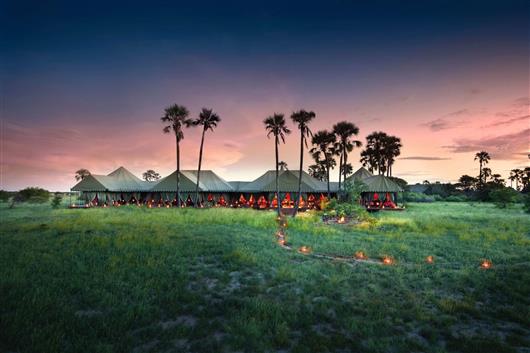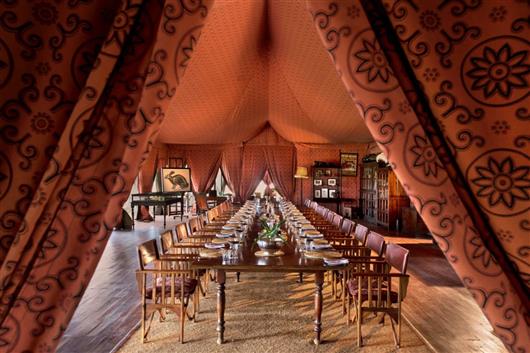



The brand-new Jack’s Camp pays homage to the property’s enduring and much-loved 1940s campaign style. The guest tents, seven twins and two doubles, are much larger and each is 270 square metres in size. The iconic interiors remain and are embellished with rich textiles from around the world, Natural History Museum cabinets, and an overhead bed cooling system. Ensuite bathrooms have both indoor and outdoor showers and outside, each veranda has a private plunge pool.
The new, larger mess tent is resplendent with the renowned Natural History Museum, library, antique pool table and a well-stocked drinks chest. The iconic nomadic Persian tea tent has been made larger and the shop has been renovated and restocked with new treasures.
Adorned with a classic East African safari feel, the nine guest rooms, 7 twin tents featuring two queen-size beds and 2 double tents with extra-length king beds, have almost doubled in size. Whilst the iconic green canvas and muslin-draped walls remain, each tent is embellished with Persian and North African rugs, paraffin lamps, brass fittings, luxuriant textiles and mahogany campaign furniture.
There is a comfortable living area, with a sofa and day bed for expansive views of the Kalahari. You’ll discover Natural History Museum cabinets curated by Ralph Bousfield himself, an overhead bed cooling system to ward off the desert heat and an en-suite bathroom with indoor and outdoor showers. Outside, each veranda has a private deck with a sparkling plunge pool as well as several velvet-clad chairs overlooking the glittering ancient landscape.
The new, larger mess tent still houses the renowned Natural History Museum, library, vintage 36 seater dining table that served as an officer’s mess table in the 1820’s, well-stocked drinks cabinet and antique pool table. The iconic, nomadic Persian tea tent remains, now a little larger in size. Framed Peter Beard pictures sit alongside original posters from French taxidermist Deyrolle, both complemented by Bousfield family photos. The swimming pool pavilion is still the only one of its kind in Africa.
Jack’s Camp is a year-round destination, yet the two seasons couldn’t be more different. The dry season, from April to October, is the desert as you know it: a shimmering whiteness envelops the scorched landscape, like a mirage floating over the crusted salt, and you’ll spot nomadic herds in the distance, as if an illusion. This is the time of year for whizzing across the pans on the back of a quad bike, sleeping under the stars, and enjoying the pans in their most iconic state.
When the rains start to fall in November, the Makgadikgadi Pans are transformed. It’s a time of plenty (even in the desert), and the salt flats are turned into watery grasslands, almost unrecognisable from the previous months. A layer of emerald-green grass stretches out in every direction, pink clouds of flamingo and flocks of migratory birds arrive to nest, and Africa’s second largest mammal migration of wildebeest and our black and white striped friends floods the plains. The green season in the desert is one of Africa’s, great unpredictable spectacles, and a magical time to visit.
Rain transforms everything, turning the pans into lush grasslands from November onwards. Animals are on the move and the desert becomes a green oasis teeming with life, notably thousands of zebra and blue wildebeest that feast on the sweet summer grasses. The safari activities are similar in these months although you usually won’t travel as far; on many days you can see the wildlife direct from your veranda. This green season continues until mid-April and corresponds with the off season for tourism in Botswana, making it a slightly cheaper time to travel.
One of the most original and exciting camps in Africa, the safari experience at Jack’s is unique. Here the living desert is constantly full of surprises. At first sight, the lunar-like salt pans appear devoid of life, but in the hands of the of the knowledgeable camp guides the story of the Makgadikgadi begins to unfold. Throughout your stay you will find an impressive choice of extraordinary activities and desert culture experiences to enjoy in and around camp.
Year Round
• Get up close and personal with our habituated meerkats.
• Discover the secrets of the pans with the Zu/’hoasi Bushmen on a fascinating bush walk.
• Take game drives and night drives in custom built 4x4s to spot the unique desert wildlife that inhabits the pans, like the elusive brown hyena or Kalahari lion.
• Visit the Makgadikgadi National Park or the site of Chapman’s Baobab.
• Go on an thrilling helicopter flip
• Take a morning hike for scenic vistas or hunt for stone tools in the crusty salt flats of the enormous Sowa Pan.
• Embark on an adventurous horseback safari (for all levels of riders; additional charge applies, but one two-hour safari is included if staying for three nights or longer). Multi-day riding safaris are also available for experienced riders – please contact us for more information.
• After an afternoon exploring the Kalahari desert, enjoy a refreshing sundowner while watching the sun set over the pans.
Dry Season (16th April – 31st October)
• Take an exhilarating quad bike across the salt-crusted pans.
• Lie out on the pans just before night fall and watch the planetarium of stars unfold above you.
Green Season (10 January – 31 March)
• Witness the second largest migration of zebra and wildebeest in Africa (and it’s also the last remaining one in Southern Africa).